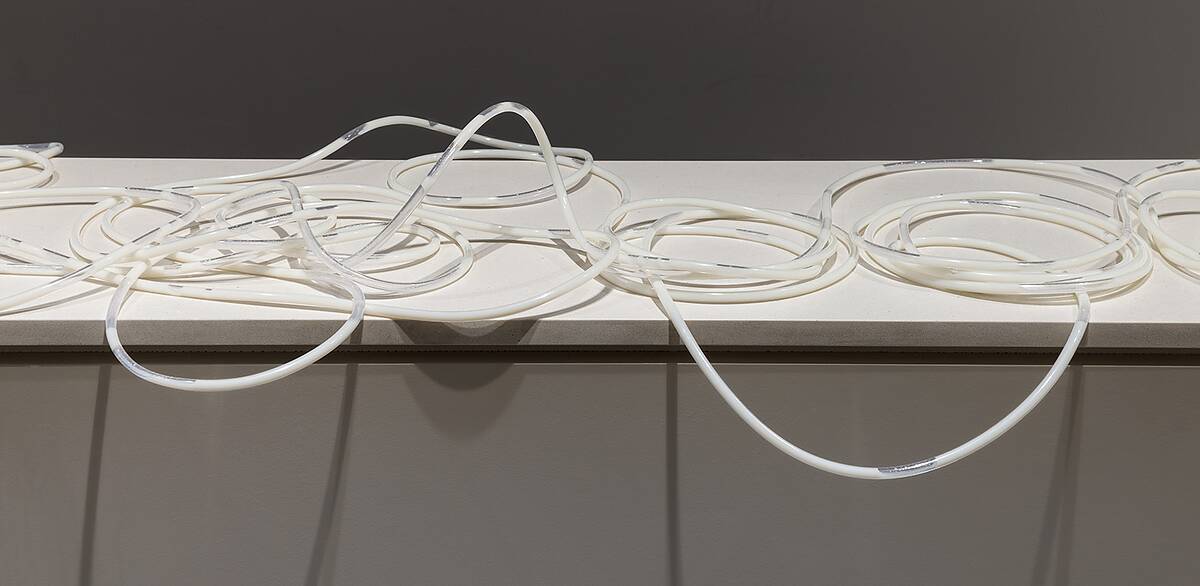
In Absentia
12AM
Stories are held in our bodies, leaving traces of ourselves and histories. Those remnants left behind can be loud, infiltrating a room, or they can be soft, subtle, nearly imperceptible.
In Absentia focuses on these spatial traces, exploring nontraditional modes of portraiture through the conspicuous absence of the body. The artists in this exhibition use bodily impressions, remnants, and residues to explore personal and social themes of loss and mourning, historical memory, unseen labor, and desire. In removing the physical body, the artists emphasize experiences and contexts that are traditionally overlooked, inviting the viewer to consider the remaining empty spaces or materials more closely. Despite removing corporeality from their work, the artists’ bodies become even more present.
It is not by design, but noteworthy, that all of the artists in this exhibition are women. Ongoing debates over women’s bodily autonomy surface in many of the works, as does the goal of preserving and protecting histories and culture. These artists are storytellers, memory keepers, and caretakers of personal and public knowledge.
Gyun Hur explores diasporic memory and personal loss through visual art, poetry, and communal experience. Composition of us and the river - “liken it to the dance” consists of glass-cast impressions of Hur’s torso filled with a mixture of water from local rivers and breast milk. Reflections of light on the shifting liquid surface change over months of display, mirroring the ways in which grief shifts and comes in waves over time. Incorporating water and milk into the negative space of her own body, Hur elicits memories of and hopes for a baptismal rebirth.
Ani Liu’s Untitled (pumping at work) circulates a facsimile of the volume of breastmilk produced by the artist during one week through a series of clear, coiled tubes that snake on and around the gallery floor and front desk. Patented in 1854, the breast pump can be considered a liberatory device, empowering women to reenter the workforce postpartum. It can also, however, be seen to create an obligation for new mothers to return to a capitalist industry that devalues the already considerable labor involved in caretaking. In displaying the milk produced by the artist disembodied from its source, Liu renders visible the often invisible labors of reproduction and motherhood. In Untitled (pumping at work) the labor of caretaking infringes on the labor of the office, overtaking the gallery desk and demanding recognition.
Joiri Minaya’s film Siboney captures the artist’s painstaking labor of painting a wall with colorful, tropical flowers and then smearing the still-wet paint off its surface. Minaya dons a white maid’s uniform for the month-long preparatory process, placing herself into the role of unseen domestic worker—a role often filled by Dominican women like herself and other people of color. In destroying the tropical, painted pattern, Minaya challenges the exoticization of Dominican domestic workers, using her own body to disrupt both idealistic tropical landscape and viewers’ desirous gaze.
Priscilla Dobler-Dzul’s ceramic vessels are imbued with both her physical imprint and the legacy of ancestral knowledge. The artist makes each clay vessel by hand, using coiling and pinch pot techniques she learned as a child from her grandmother and pressing each form against her own body while it is still wet. Once fired, the works document the muscle memory of the artist as well as of the land from which Dobler-Dzul pulls her clay. Some vessels are further personalized through the addition of sharp porcupine quills, thorns, or other materials that circumvent the artist’s body but might puncture other attempted users. The vessels are intended for ritual and performance, including the distribution of seed bombs and, drawing from her Mayan ancestral traditions, the preparation and serving of cacao. In creating a form that fits only her body, Dobler-Dzul protects it against co-optation by outsiders, preserving its sacredness and privacy even when used or placed in a public environment.
Barb Smith examines artifacts and lost histories, constructing new, playful iterations of ancient objects. Her life-size, memory foam imprints act as fabricated fossils of her own body. Smith’s forms allude to classical sculpture, revealing contrapposto-like curves, while creating partial portraits that operate like photographs, capturing fleeting moments of the artist’s embrace. Her permanent interventions in the memory foam–a material that, counterintuitively, is intended to “forget” the maker’s imprint, are labor intensive; Smith soaks the memory foam in acqua resin and then firmly embraces the material for nearly an hour in order to set its new shape. Her sculptures preserve the memory of the artist’s body, bridging scientific, archaeological study and chemical reaction with a surprising intimacy of form and material.
Juliana Cerqueira Leite created her Reaching series of sculptural shelves by casting her hands as they reached for consumer objects. The resulting colorful, layered forms capture the motion of Leite’s body rather than the shape of her hand itself. Leite considers how our desires mediate our movements and are often dictated by our constructed world–one filled with the objects, purchases, wants, and needs of capitalism. The sherbert-like coloring of her plaster sculptures underlines this consumerist appetite, playing into the viewer’s gluttony for appealing material objects.
Considering portraiture without the body expands this most traditional of genres and invites the viewer to reflect on the ways artists insert themselves and their stories into their work. Despite the apparent abstraction of many of their interventions, the artists in In Absentia ground their works in movement, bodily form, and the evidence of labor. The body, or lack thereof, becomes a charged political, cultural, or social landscape, asserting itself through its decisive absence.
- Eliana Blechman